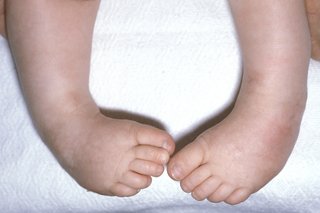Club Foot
 File photo. Credit: NHSOpens in new window
File photo. Credit: NHSOpens in new windowTalipes equinovarus (TEV) is the specific term and common type of what is sometimes called “club foot,” a term that encompasses a range of anomalies of the ankle or foot present at birth. |
Club foot is where a baby is born with a foot or feet that turn in and under. Club foot happens because the Achilles tendon (the large tendon at the back of the ankle) is too short.
- Position. Fixation of the foot (forefoot and hindfoot) in plantar flexion (equines), deviation toward the midline (varus) and upward rotation so the foot rests on its outer side (suspinatus).
- Severity. Milder cases are “positional,” meaning that the foot and ankle can be gently manipulated into a normal position. In more severe cases the foot and ankle can be “rigid” or “fixed,” in that they cannot be manipulated into a normal position and require orthopaedic or surgical treatment.
Diagnosis of Club Foot
- Prenatal — Clubfoot can be identified or suspected on prenatal ultrasound. However, it should not be included in birth defects surveillance data without postnatal confirmation.
- Postnatal. Clubfoot is readily diagnosed in the newborn examination. Cases should be followed and evaluated sequentially to assess the degree of severity and whether treatment other than manipulation is necessary.
Clinical and Epidemiologic Notes
Talipes equinovarus has a wide spectrum of severity, which is important to define because it drives management and outcomes.
- Milder cases are “positional,” meaning that the foot can be gently manipulated into a normal position and typically does not require orthopaedic or surgical interventions. Positional talipes is excluded in surveillance.
- More severe cases are “rigid” or “fixed,” meaning the foot cannot be manipulated into a normal position and requires orthopaedic or surgical treatment.
Imaging is very helpful but a clinical examination in expert hands can provide a firm diagnosis. Additional clinical tips:
- Talipes equinovarus can occur with deformations in other joints (e.g.., elbow, hands, knees) — check and report.
- Talipes equinovarus can be due to many syndromes and disorders, especially of the brain and bone/cartilage — evaluate carefully.
- Be sure to differentiate TEV from other types of “clubfoot,” such as talipes calcaneovalgus, common in trisomy 18 (in which the ankle joint is dorsiflexed instead of plantar flexed, and the forefoot deviated outwards); and talipes calcaneovarus (in which the ankle joint is dorsiflexed, and the forefoot deviated inwards).
Club foot can affect 1 or both feet. It's not painful for babies, but it can become painful and make it difficult to walk if it's not treated. Nearly all children with club foot are treated successfully.
Most should be able to take part in regular daily activities. They will learn to walk at the usual age, enjoy physical activities and be able to wear regular footwear after treatment.
Children who only have 1 affected foot may be left with a slightly shorter leg and a smaller foot. This may mean your child is slightly less mobile and gets tired more quickly than other children.
Causes of Club Foot
In most cases the cause of club foot is not known. There may be a genetic link, as it can run in families. If you have a child with a club foot or feet, your chance of having a 2nd child with the condition is about 1 in 35. If 1 parent has a club foot, there's about a 1 in 30 chance of your baby having it. If both parents have the condition, this increases to about a 1 in 3 chance. In rare cases, club foot is linked to more serious conditions, such as spina bifida.

